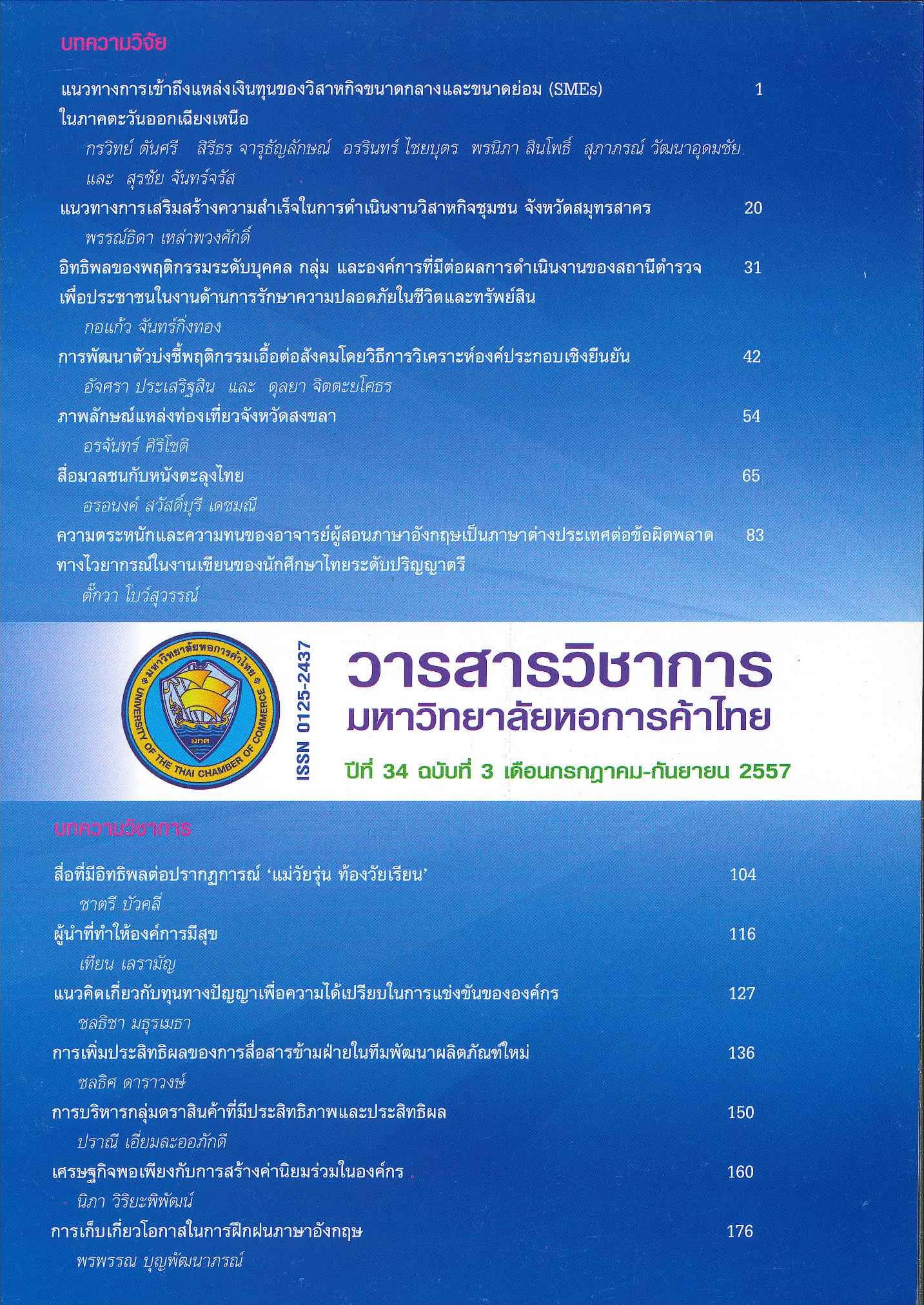Opportunities for Practicing English: It Is a Matter of Picking Them up
Main Article Content
Abstract
Speaking English has always been a major problem for Thais. Though it has been brought into focus in all educational institutions, practicing speaking in class is still often problematic. Role-plays and simulations are created to enhance students’ abilities. However, practicing in genuine real-world situations is without equal. Thailand is not an English speaking country but opportunities for practicing English are not too difficult to find. Various activities related to tourism can be designed and assigned to promote both language practice and contribution to the community. Several factors and adjustments are presented for consideration. Activities and preparation are suggested to be practically used to suit each institution’s context.
Article Details

This work is licensed under a Creative Commons Attribution-NonCommercial-NoDerivatives 4.0 International License.
ลิขสิทธิ์ของบทความ
ผลงานที่ได้รับการตีพิมพ์ถือเป็นลิขสิทธิ์ของมหาวิทยาลัยหอการค้าไทย ห้ามมิให้นำเนื้อหา ทัศนะ หรือข้อคิดเห็นใด ๆ ของผลงานไปทำซ้ำ ดัดแปลง หรือเผยแพร่ ไม่ว่าทั้งหมดหรือบางส่วนโดยไม่ได้รับอนุญาตเป็นลายลักษณ์อักษรจากมหาวิทยาลัยหอการค้าไทยก่อน
References
Upper Saddle River: Prentice Hall.
Bangkok Post Reporter. 2012, July 27. English Skills Below Asean Partners [Online]. Available: http://www.bangkokpost.com/news/local/304600/thai-ranks-no-42-in-english
Beare, K. 2013. Improve English Quickly-Teaching Tips [Online]. Available: esl.about.com/od/Intermediateenglish/a/learn_English_quickly_2htm
Boonpattanaporn, P. 2012. “Thai Students’ English Proficiency and the New World of AEC.” University of the Thai Chamber of Commerce Journal. 32,3: 214-228.
Canadian as a Second Language Institute. 2013. Practical Conversation English [Online]. Available: www.csli.com/programs/courses/practical-english.php
Canale, M. 1983. “From Communicative Competence to Communicative Language Pedagogy.” In Richard, C. and Schmidt, R. (Eds.) Language and Communication. pp. 2-27. New York: Longman.
Center for Teaching Excellence, University of Maryland. 2013. Large Classes: Seven Pinciples of Good Teaching [Online]. Available: www.cte.umd.edu/library/teachingLargeClass/ guide/appA.html
Chanchokpong, N. 2012. Thai Education Reform for AEC [Online]. Available: http://202.47.224.92/en/news.php?id=255501060021
Darasawang, P. 2007. “English Language Teaching and Education in Thailand: A Decade of Change.” In D. Prescott (ed.), English in Southeast Asia: Varieties, Literacies and
Literature, pp. 187-204. Newcastle: Cambridge Scholar Publishing.
Getmanee, B. 2005. “Components Contributing to English Oral proficiency: A Case Study of theUndergraduates of King Mongkut’s Institute of Technology North Bangkok.” Journal of Industrial Technology. 1: 52-2-59.
Hua, H. 1985. “Chinese EFL Students’ Learning Strategies for Communication.” TESOL Quarterly. 19: 167-168.
Jandt, F. 2013. An Introduction to Intercultural Communication: Identities in a Global Community. 7thed. Los Angeles: SAGE Publications.
Jarupan, S. 2013. “The English Oral Communication Competency of Thai Engineering Students.” International Journal of Scientific and Research Publication [Online serial]. Available: http://www.ijsrp.org/research-paper-0313.php?rp=P15836
Khamkhien, A. 2011. “Quantitative and Qualitative Views of Thai EFL Learners’ Learning Oral Communication Skills.” Academic Research International 1: 90-103.
Khaopa, W. 2011, September 8. “Students Should Be Ready for Place in New ASEAN.” The Nation [Online]. Available: http://www.nationmultimedia.com/national/Students-should-be- ready-for-place-in-new- Asean-30164773.html
Klein, W. 1990. Second Language Acquisition. London: Cambridge University Press.
Luchini, P. 2004. “Developing Oral Skills by Combining Fluency with Accuracy-focused Tasks: A Case Study in China.” Asian ELT Journal. 6,4: 1-20.
Lustig, M. and Koester, J. 2013. Intercultural Competence: Interpersonal Communication Across Cultures. 7th ed. Upper Saddle River: Pearson Education.
Methitham, P., and Chamcharatsri, P. 2011. “Critiquing ELT in Thailand: A Reflection from History to Practice.” Journal of Humanities, Naresuan University. 8: 57-68.
Myles, J. 2009. “Oral Competency of ESL Technical Students in Workplace Internships.”TESL_EJ [Online serial]. Available: http://www.tesl-ej.org/wordpress/issues/ volume13/ej49/ej4942/
National Institute of Educational Testing Service. 2011. Basic statistics of Ordinary National Educational Test scores level 4 (Matayom 6) [Online]. Available:
http://www.onetresult.niets.or.th/AnnouncementWeb/Login.aspx?ReturnUrl= %2fannouncementweb%2fDefault.aspx (in Thai).
สถาบันทดสอบทางการศึกษาแห่งชาติ. 2556. ค่าสถิติพื้นฐานผลการทดสอบทางการศึกษาระดับชาติขั้นพื้นฐาน (O-NET) ช่วงชั้นที่4 (มัธยมศึกษาปีที่ 6) [ออนไลน์]. เข้าถึงจาก http://www.onetresult.niets.or.th/AnnouncementWeb/Notice/ FrBasicStat.aspx
Ngamsaithong, N. 2012. Thailand Behind Other ASEAN Nations in English Language [Online]. Available: http://202.47.224.92/en/news.php?id=255507300009
Nunan, D. 2003. Practical English Language Teaching. Singapore: McGraw Hill.
Phuetphon, P., Chayanuvat, A. and Sitthitikul, P. 2012. Using Unscripted Role Play to Improve Speaking Ability of Thai EFL Students [Online]. Available: http://sv.libarts.psu.ac.th/conference5/ proceedings/Proceedings4/article/1pdf/006.pdf
Plailek, T. 2011. “Factors Affecting English Speaking Ability of Second Year English Major Students in the Faculty of Education, Rajabhat Universities in Bangkok Metropolitan Area.” Journal of Research and Development. 3: 52-58. (in Thai).
ธีราภรณ์ พลายเล็ก. 2554. “ปัจจัยที่มีผลต่อการพูดภาษาอังกฤษของนักศึกษาชั้นปีที่ 2 สาขาวิชาภาษาอังกฤษ คณะครุศาสตร์ มหาวิทยาลัยราชภัฏในเขตกรุงเทพมหานคร.” วารสารวิจัยและ พัฒนา. 3, 52-58.
Rongsa-ard, Antikar. 2003. “The Study of Chulalongkorn University Students’ Attitude Towards Questioning Strategies Used by Teachers in English Classrooms.” Pasaparitat [online serial]. Available: http://www.culi.chula.ac.th/e-Journalt/research_09.htm (in Thai).
อัญฑิการ์ โรงสะอาด. 2546. “การศึกษาเจตคติของนิสิตจุฬาลงกรณ์มหาวิทยาลัยในเรื่องการตอบคำถามครูผู้สอนในชั้นเรียนภาษาอังกฤษ”. วารสารภาษาปริทัศน์ [วารสารออนไลน์]. เข้าถึงจาก http://www.culi.chula.ac.th/e-Journalt/research_09.htm
Saengpassa, C. 2012, January 5. “Woravat’s Puzzling Big Plans.” The Nation [On-line].Available: http://www.nationmultimedia.com/national/Woravats-puzzling-big-plans- 30173157.html
Samimy, K. and Tabuse, M. 1992. “Affective Variables and a Less Commonly Taught Language: A Study in Beginning Japanese Classes.” Language Learning. 42: 377-398.
Savignon, S. 2002. “Communication Language Teaching: Linguistic theory and Classroom Practice.” In S. Savignon (ed.) Interpreting Communicative Language Teaching: Contexts and Concerns in Teacher education. pp. 1-27. New Haven: Yale University
Scrivener, J. 2012. Classroom Management Techniques. New York: Cambridge University Press.
Singhapreecha, P. 2001. Thai classifiers and the Structure of Complex Thai Nominals [Online]. Available: aclweb.org/anthology/Y/Y01/Y01-1024.pdf
Suwannarak, K. 2012. “English Language Learning Beliefs, Learning Strategies and Achievement of Masters Students in Thailand.” Tesol in Context Special Edition 3 [Online serial]. Available: http://www.tesol.org.au/files/files/275_kasma_suwannarak.pdf
Thompson, G. “Some Misconceptions about Communicative language.” ELT Journal, 50, 1: 9-15.


